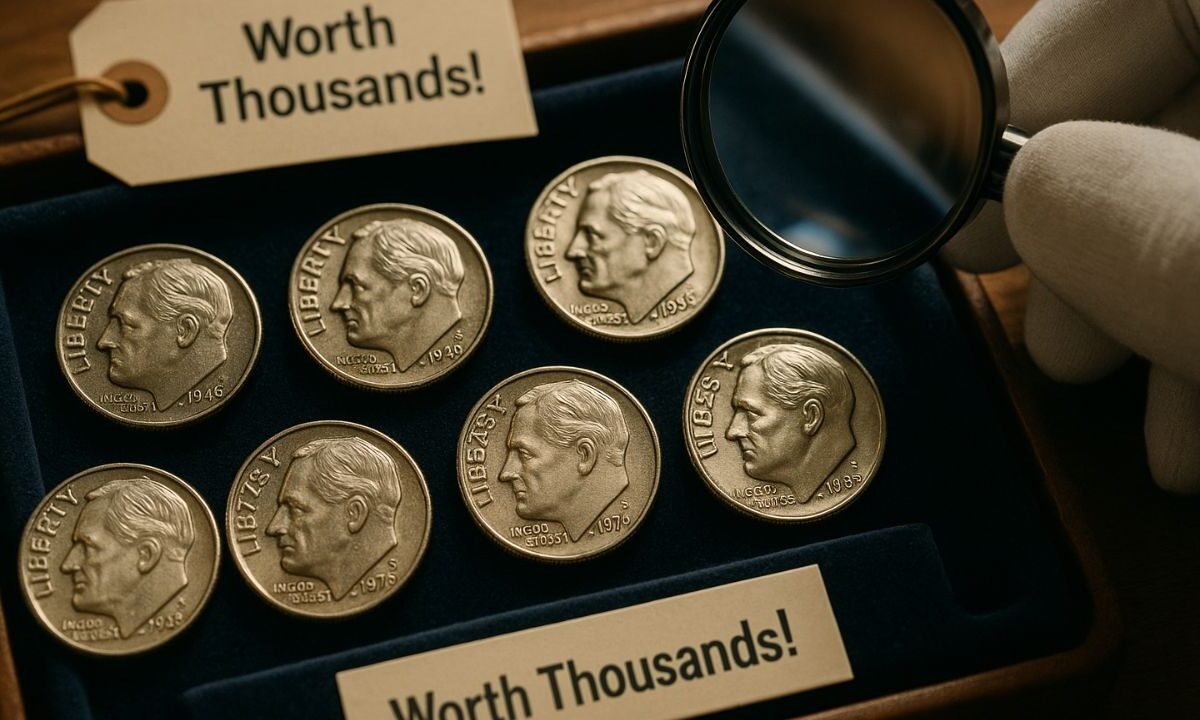Most Roosevelt dimes are worth only their face value of 10 cents. However, certain rare dates or mint-mark/planchet errors make a dime suddenly worth hundreds, thousands or even hundreds of thousands of dollars.
For example, proof coins missing the “S” mint mark, business strikes missing the “P,” or coins struck on the wrong metal planchet are major finders for collectors.
Errors like these are often small in number, documented and highly sought after.
The 7 Dimes to Know
Here are seven specific varieties of the Roosevelt Dime that are notably rare and valuable:
1) 1975 No-“S” Proof Roosevelt Dime
This coin is from the San Francisco Mint proof production in 1975, yet it lacks the “S” mint-mark that all normal 1975-S proof dimes should have. Only two known examples exist. One sold for $456,000 and another set a record of $506,250.
Why it’s special: The missing mint mark is a very dramatic error for a modern U.S. coin and the scarcity makes the premium huge.
2) 1968 No-“S” Proof Roosevelt Dime
In 1968 proofs from San Francisco should bear an “S” mint-mark. A tiny number escaped with none. High-grade specimens have sold in the tens of thousands of dollars.
What to look for: Mirror-like proof surfaces, ultra-sharp details, and no “S” next to the date.
3) 1970 No-“S” Proof Roosevelt Dime
Again a “missing S” proof from San Francisco in 1970. Not quite as intensely valuable as the 1975 variety, but still very much collector-worthy. Sales run from hundreds into the low thousands depending on grade.
Tip: Verify it’s a proof finish, not a business strike.
4) 1983 No-“S” Proof Roosevelt Dime
In 1983 another proof from San Francisco turned up without the “S.” Modern-era, but still rare. Certified deep-cameo high-grade examples have reached near the four-figure mark.
Note: Modern errors like this often carry big premiums only if grade and finish are top notch.
5) 1982 No-“P” Business-Strike Roosevelt Dime
Unlike the previous proof errors, this one is a circulation (business) strike from Philadelphia in 1982 where the “P” mint-mark was omitted.
A normal business-strike dime bears no mint-mark before 1980, but by 1982 “P” should appear — so a missing mint mark where one should be is an error.
Value range: From about $100–$600+ for moderate grades, and much more for ultra-high grade.
6) 1964 SMS (Special Mint Set) Roosevelt Dime
In 1964 the Mint issued Special Mint Sets (SMS) with higher quality finishes. Some 1964 SMS Roosevelt dimes have proof-like surfaces, sharp banding on the torch, and very limited quantities. These can realize mid-four to low-five figure values depending on grade.
What to watch for: The SMS finish (distinct from regular business or proof), crisp details, and full bands on torch.
7) 1965 Silver-Planchet Transitional Error Roosevelt Dime
1965 is the year the dime switched from 90% silver to copper-nickel clad.
A few 1965 dimes were struck on leftover silver planchets (90% silver), making them very rare. Auction sales for these have been in the several-thousand dollar range.
How to detect: Weight matters — a silver planchet dime will weigh ~2.50 g versus ~2.27 g for clad. Also look for the correct date (1965) and confirm it was struck on silver not intended clad metal.
Quick Reference
| Coin / Variety | What to Look For | Typical Market Range* | Recent Headline Sale |
|---|---|---|---|
| 1975 No-“S” Proof | Proof finish, no “S” mint-mark | High five- to six-figures | ~$506,250 |
| 1968 No-“S” Proof | Proof finish, no “S” mint-mark | Tens of thousands | — |
| 1970 No-“S” Proof | Proof finish, no “S” mint-mark | Hundreds to low thousands | — |
| 1983 No-“S” Proof | Proof, no “S” mint-mark, modern era | Mid-hundreds to ~$1,000+ | — |
| 1982 No-“P” Business Strike | Circulation strike, no “P” mint-mark | $100–$600+ (better grades much higher) | — |
| 1964 SMS Roosevelt Dime | Special Mint Set finish, sharp details | Mid-four to low-five figures | — |
| 1965 Silver Planchet Transitional | 1965 date on silver planchet (~2.50 g weight) | Several thousand dollars | ~$7,800 |
*Market range depends highly on grade, certification, finish, and rarity of that specific example.
Pro Tips to Confirm Authenticity
- Always magnify the mint mark area (5× or 10×) to ensure the mint mark is truly missing, not just weak or worn.
- If you believe you have a 1965 silver-planchet error, use a scale and check the weight (~2.50 g for silver vs ~2.27 g clad).
- For proof errors (missing “S”), verify the coin has classic proof characteristics: mirror-fields, sharp frosted devices, cameo or deep cameo contrast.
- Only buy/sell via trusted dealers or auction houses; grading by certified services adds substantial value.
- Keep documentation and provenance where possible — rarity claims are only as good as the evidence backing them.
Don’t dismiss a seemingly ordinary dime. If you find a Roosevelt dime with a missing mint mark, or one struck on the wrong metal, or one from a special mint set finish, you could be looking at a coin worth thousands—or even hundreds of thousands—of dollars.
These are not mere speculative claims: auction records and collector demand confirm the real value is out there.
Always inspect carefully and consider certification before assuming face value.
FAQs
Where is the mint mark on a Roosevelt dime?
On the Roosevelt dime (post-1968) the mint mark appears to the right of the date on the obverse. On earlier silver-date dimes (1946-64) the mint mark is on the reverse near the torch.
How can I quickly tell if a 1965 dime is the rare silver-planchet error?
Weigh the coin: if it is about 2.50 g instead of ~2.27 g, it very likely was struck on a silver planchet. Also examine for silver surface (toning, silver colour) not copper-nickel clad.
Are modern-era Roosevelt dimes (post-1980) ever really valuable?
Yes — while most are worth only face value, specific modern‐errors like a 1982 no-“P” business strike or a 1983 no-“S” proof can command substantial premiums if certified and in top grade. Always check for error/mint mark anomalies.

